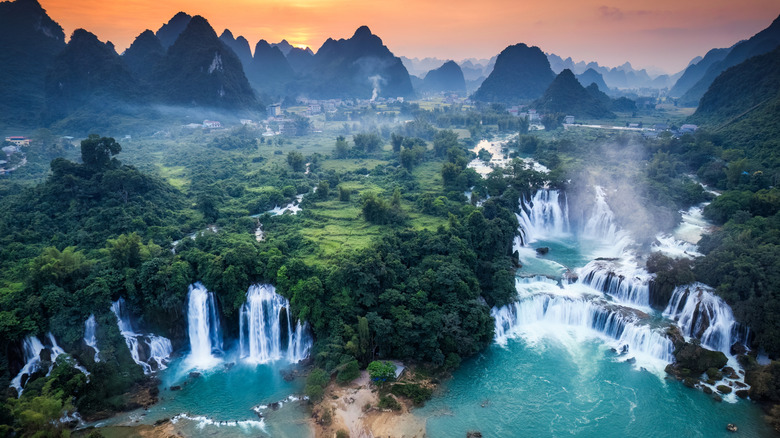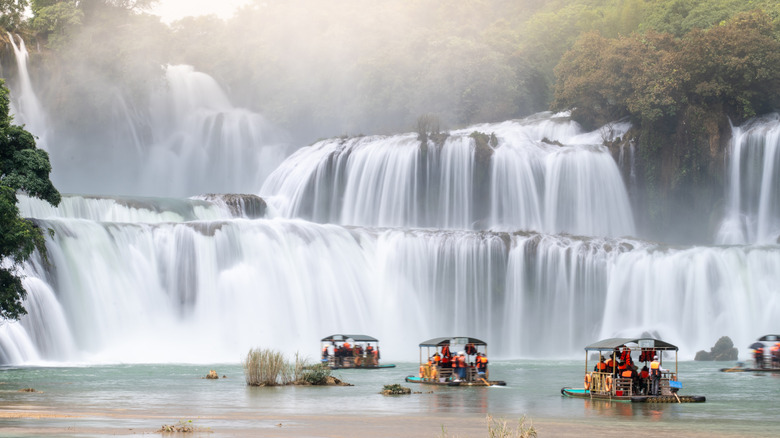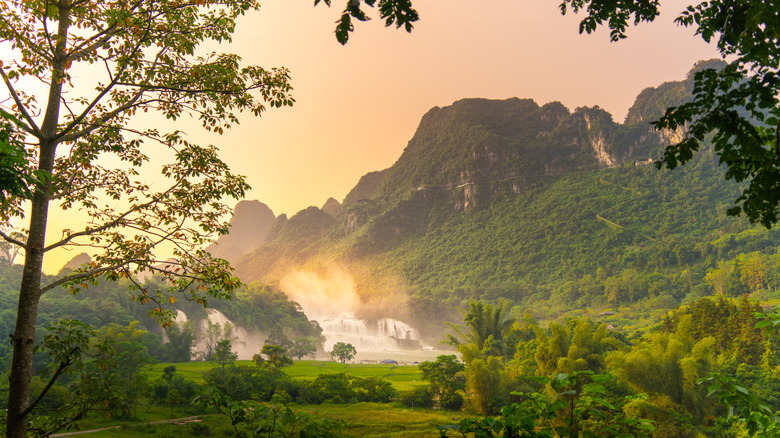The Massive Waterfall That Connects Two Asian Countries With Roaring Beauty
In Vietnam, there are waterfalls known as Ban Gioc, and it's hard to believe such beauty exists. The karst mountains that rise in the background look like clusters of cloaked figures. The forests and rice paddies form a green quilt across the valley. Then there are the falls themselves, pouring over verdant cliffs and pooling in multiple tiers. The landscape looks like some mythical place, painted into being by a divine artist, too magnificent to occupy regular old earth.
But in China, the falls are called the Detian Waterfall, and there is a reason for the two names: the Ban Gioc-Detian Waterfalls straddle the border between the two countries. In truth, they're two different waterfalls, which stand side-by-side and are sliced into multiple cascades. To the Vietnamese, the falls are grouped together into a single entity, measuring more than 650 feet across and dropping about 230 feet from top to bottom. To the Chinese, Detian refers to the falls on their side of the border, while the Vietnamese half is called Banyue.
This national border is widely considered one of the most beautiful waterfalls in the country, and the site has inspired goodwill between the two nations. In 2023, a special Cross-Border Tourism Cooperation Zone was established around the falls, permitting visitors from both Vietnam and China to explore the area without bureaucratic hassles. Given these two governments' complex — and sometimes caustic — relationship, Ban Gioc-Detian Falls represent some (literal) common ground.
What to do at Ban Gioc-Detian Falls
Thankfully, there are no buildings directly around the falls — preserving the natural vistas. The Quay Son River flows peacefully to the waterfalls' edge, unobstructed by bridges or dams. Just beyond, though, you'll find well-developed park paths for hikers as well as nearby motorbike tours. The most popular activity is to ride a boat across the lower pool and feel the falls' spray. This can be done from both the Chinese and Vietnamese sides, and the sheltered, flat-bottomed boats get remarkably close to the crashing torrents. Visitors should naturally wear water-friendly garments and protect their electronics. Although this region gets extremely hot and humid in the warmer months (overlapping a North American summer), it also gets quite chilly in the winter, dropping to the low 50s at night –– so you'll want to dress accordingly. In general, there are some other cautions you should consider when dressing in China as well.
The surrounding area is packed with activities. You can visit the village of Phia Thap, a traditional community of the rural Tay people, as well as the Trung Khanh District, home of the Nung people. Artisans display distinctive crafts, and you will likely catch a live performance of local folk music, known as "then." Nearby, you'll find the 7,000-foot-deep Ngưom Ngao Cave, with its unearthly mineral formations, as well as the Phat Tich Pagoda, a Buddhist structure atop a mountain that has been in existence for over 1,000 years. This region is also popular among motorcyclists and kayakers, and tours can be arranged for both.
The long road to Ban Gioc-Detian Falls
The one drawback to visiting the Ban Gioc-Detian Falls is getting there. The site is over 200 miles from Hanoi, Vietnam's capital. Hanoi, on its own, is an excellent destination in Asia for a budget-friendly trip and home to the biggest airport in northern Vietnam, but if you're planning on going to the falls, you've got quite a long way to go. Meanwhile, it's also over 140 miles from Nanning, another city in southern China. In short, Ban Gioc-Detian Falls aren't exactly near any large cities or airports, and you'll have to spend a good number of hours getting here by bus, even when starting from these busy metro areas.
Once you arrive, though, there are dozens of hotels and homestays on both sides of the Chinese-Vietnamese border, most of them costing the equivalent of $20 or less per night (though prices can always change). You'll find plenty of restaurants nearby as well. If you're planning to cross the border here — beyond the Cooperation Zone — note that U.S. citizens can receive a 90-day visa to Vietnam upon arrival, but entering China requires a complex visa application process that must be secured ahead of time. Frankly, there are a lot of things to know before traveling to China.


